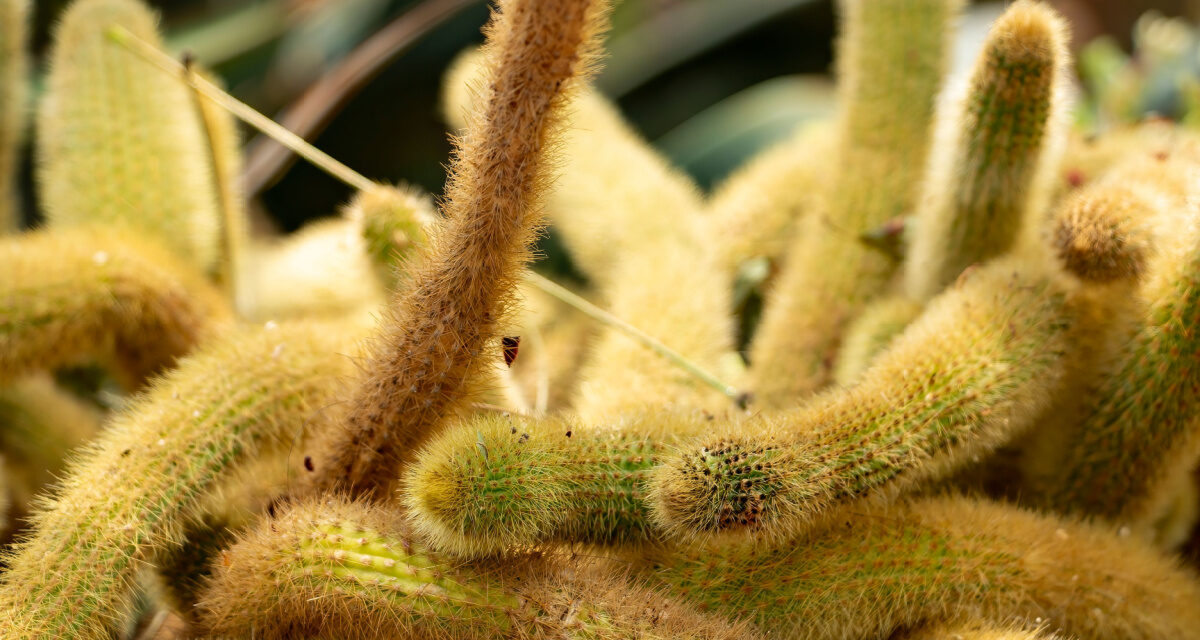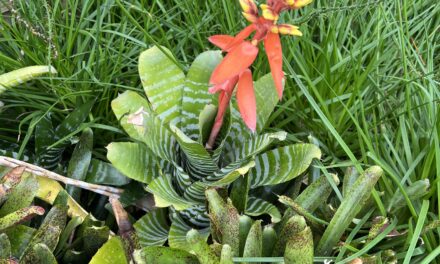If your rat tail cactus is looking a little limp, don’t fret. While the rat tail cactus isn’t particularly hardy, this plant can, sometimes, recover from issues like cold weather and overwatering. We’ll be discussing how you can revive your rat tail cactus below, along with the basics of how to care for this fascinating plant.
Whether it’s your first time taking care of a rat tail cactus, or you’re just looking for a bit of a refresher regarding proper care, this guide should help. There’s a lot you’ll need to keep in mind when it comes to taking good care of a rat tail cactus, so it may not be the best cactus for beginners. Nevertheless, let’s get started!
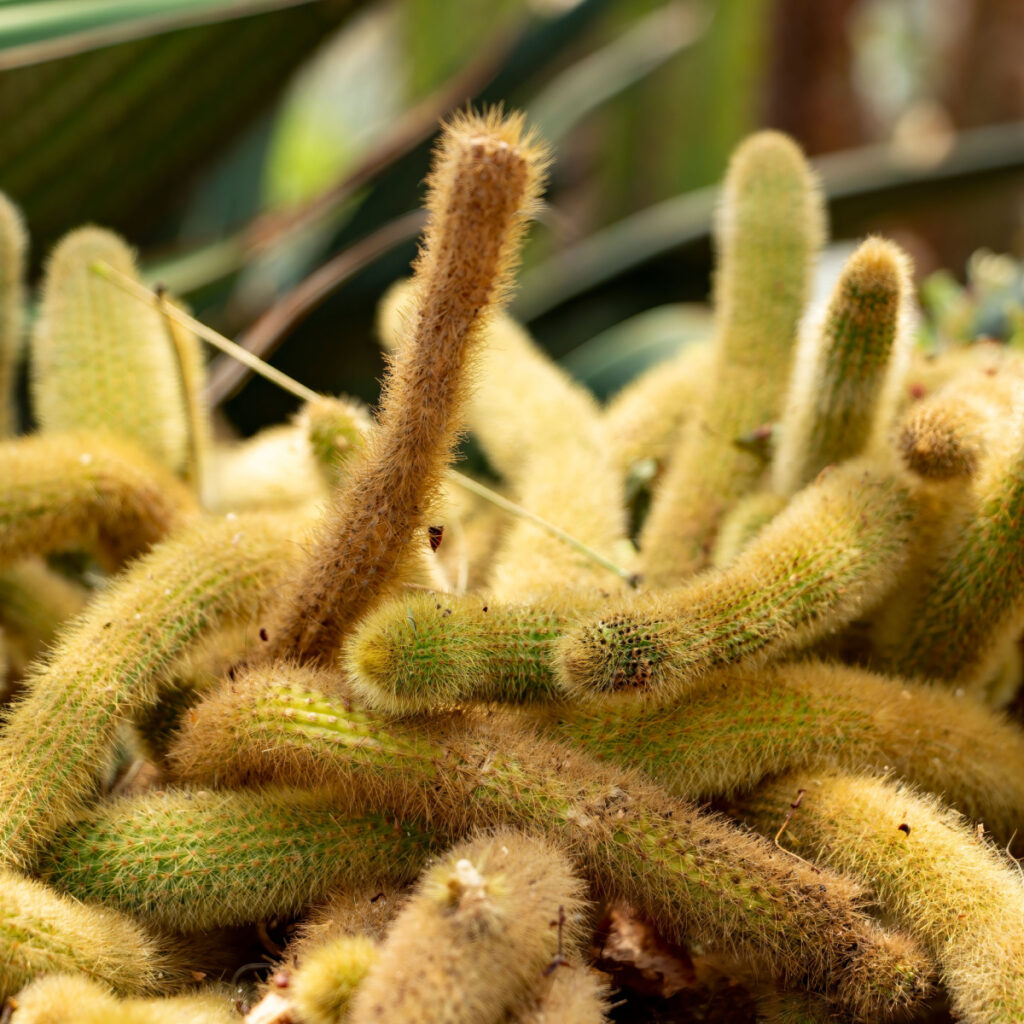
What is a Rat Tail Cactus?
The rat tail cactus is a striking plant found naturally in the southwestern regions of Mexico and some parts of Central America. It stands out with its long, drooping stems, reaching up to 4 feet long when fully grown (which is, very likely, how it earned its nickname).
During the spring and early summer, the rat tail cactus blossoms with flowers, typically in a violet-red hue. Occasionally, you might spot flowers in unique shades like pink or orange. These flowers are tube-shaped and quite sizable, about 2 inches across.
Despite the plant producing many flowers during its late spring bloom, each flower only lasts for a couple of days at most. It’s best to plant the rat tail cactus in the springtime to give it the whole growing season to take root.
In its natural habitat, the rat tail cactus can be found either growing on rocks or latching onto larger structures like trees. When cultivated, it’s often grown in hanging pots or baskets due to its trailing stems. Needless to say, it’s quite an interesting-looking cactus! Like most cacti, the rat tail cactus is drought-tolerant, and can survive for long periods of time in the right conditions.
Proper Rat Tail Cactus Care
Taking care of your rat tail cactus requires some attention to detail, but it’s relatively low-maintenance. Unless you live in USDA zones 10 or 11, where it can thrive outdoors year-round, it’s best kept indoors for most of the year.
During the warmer months, you can bring it onto your patio or deck, but be mindful of its sharp spines. It’s best to find a safe spot for it where you, your kids, or your pets won’t accidentally brush against it. Let’s take a look at what goes into taking proper care of a rat tail cactus below:
Light
This cactus loves the sun, and thrives in bright, direct sunlight. We’d recommend placing it in a south- or west-facing window, as that will provide it with the amount of sunlight it needs to flourish.
Soil
When potting your rat tail cactus, you’ll need to make sure to use a lightweight potting mix. The reason for this is that it’s important that your rat tail cactus is able to drain. In terms of soil, a slightly acidic pH, typically between 5.0 and 6.0, is ideal for rat tail cacti. Most commercial cactus potting mixes offer this, so it shouldn’t be too difficult to find.
Watering
Despite its desert origins, the rat tail cactus does appreciate regular watering during the growing season. Keep in mind that you don’t need to give it too much water — just enough to keep the soil slightly moist. As fall approaches and winter sets in, you’ll want to reduce watering gradually, and during its dormancy period (usually in winter), water it sparingly, if at all.
Temperature
In terms of temperature and humidity, this cactus is quite resilient. It can withstand temperatures ranging from 45 to 90 degrees Fahrenheit. It doesn’t do well in freezing temperatures, though, so make sure to keep a close eye on it during the winter months.
Usually, normal room temperatures are suitable for this plant, with nighttime temperatures ideally falling between 60 to 70 degrees Fahrenheit. When it comes to humidity, the rat tail cactus prefers moderate humidity levels. Too much moisture can cause its stems to rot, and overly dry conditions may attract spider mites.
Fertilizer
To keep your rat tail cactus healthy, you’ll need to fertilize it with a diluted liquid fertilizer every two weeks during the growing season (spring and summer). This will provide it with the nutrients it needs to thrive and produce its beautiful flowers.
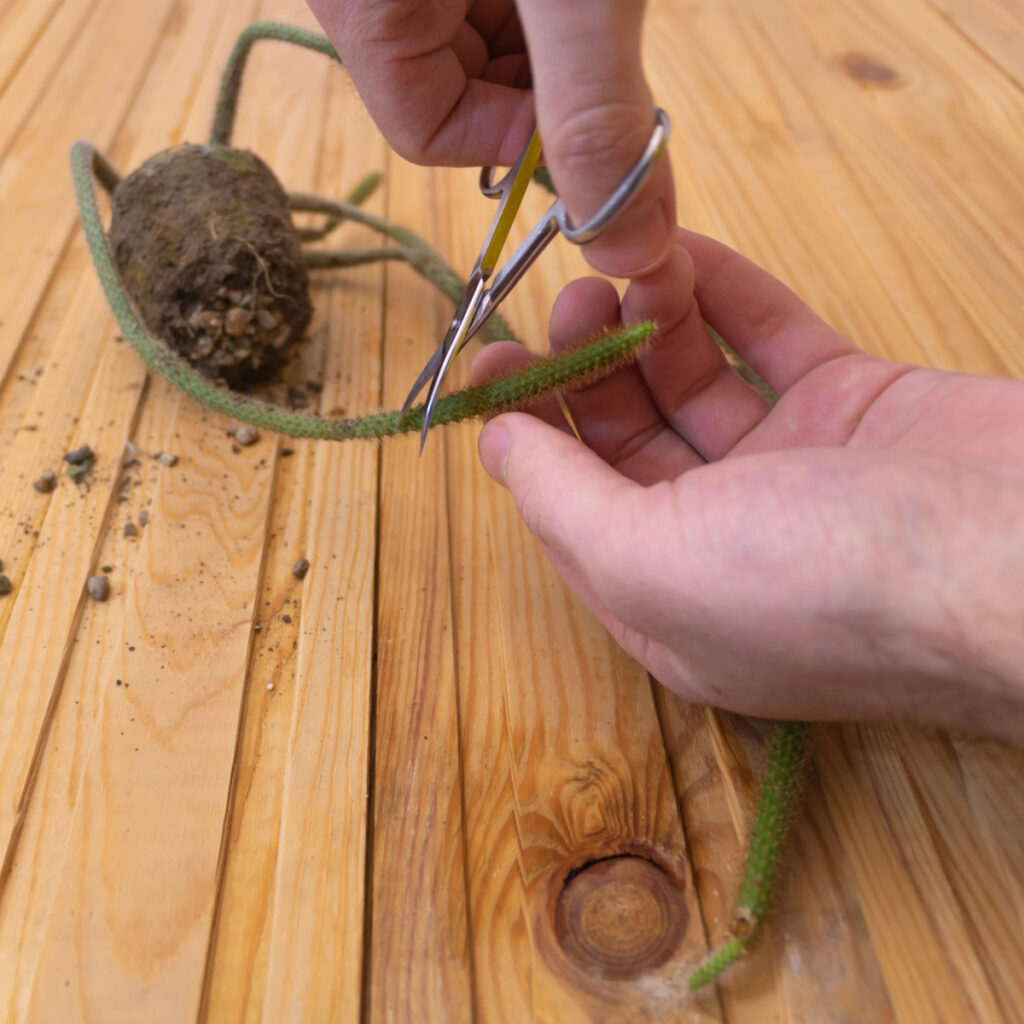
Pruning and Propagating
Pruning a rat tail cactus is pretty straightforward. As with most plants, pruning your rat tail cactus will just be a matter of carefully removing any sick or dead parts that are keeping the cactus from growing properly. Remember, you’re working with a cactus here, and the rat tail’s spines are pretty unforgiving, so wear gloves!
When it comes to propagating new rat tail cactus plants, the first thing you’ll need to do is pick a healthy stem and cut a 6-inch piece of it with a sharp knife. Let the cut end dry for about three days until it toughens up.
From there, you’ll want to fill a pot with cactus soil. Make a hole in the middle using a pencil or stick, and put the cut end of the stem into the hole. If you like, you can use a wooden skewer to help keep it steady.
Put the pot in a sunny spot, but don’t let the soil dry out completely. If you can, keep the air around it nice and moist. With the right care, the cutting will start to grow roots within a few weeks, and you’ll have yourself a new rat tail cactus to take care of!
Potting and Repotting Your Rat Tail Cactus
If you love the look of a plant in a hanging basket, then you’re in luck — the rail tail cactus looks great when grown in a hanging basket. Once again, this is due to the way that the rat tail cactus grows in the wild (latched onto trees). We’d recommend lining the basket with organic material, like sphagnum moss, before putting in the cactus potting mix.
You’ll need to repot your rat tail cactus every year or so once the growing season is over. It’s likely that you’ll also need to transfer your rat tail cactus to a larger basket (or pot), since it’s quite a big cactus when it’s fully matured. Either way, it will need new potting soil, since it uses the nutrients from the soil pretty quickly.
How to Revive a Dying Rat Tail Cactus
Perhaps this article caught your eye because your rat tail cactus isn’t doing too hot. There are a lot of reasons why your rat tail cactus might be sick — from root rot, to spider mites, to damaged parts, there’s really no telling what could cause this sensitive cactus to wither and die. The good news is, the rat tail cactus is actually pretty easy to save (if it’s not too far gone).
If your cactus has brown, dry, or damaged sections, you’ll want to get rid of them and start fresh. Starting fresh will also help with problems like root rot and parasites — or, at the very least, it can prevent these problems from getting worse.
To revive your rat tail cactus, you’ll need a good pair of pruning shears, a pot with holes in the bottom (for proper drainage), lightweight soil, and some bits of oyster shell (for the sake of providing the plant with extra nutrients).
It’s a good idea to use a pot that’s a bit smaller than the old one — this will help the plant focus solely on growing new roots. Mix the soil with the oyster shell bits to air it out and make sure it’s nutrient-rich.
After cutting off the unhealthy parts of your rat tail cactus, let the healthy cuttings dry and make sure that they’re facing the right way. Put them in the pot you’ve prepared, and arrange them how you’d like. After that, water them lightly. Make sure not to overwater them so that the plant doesn’t experience more root rot.
Put the pot in a sunny spot with indirect sunlight and slowly increase how often you water it as the plant starts growing again in the spring. Keep in mind that taking these steps may not work for a rat tail cactus that’s mostly dead. If your rat tail cactus has somehow gotten frozen, for example, it may be too far gone.
Final Thoughts
Taking proper care of a rat tail cactus isn’t necessarily the easiest thing in the world, but once you get the hang of it, you’ll get to see your rat tail cactus flourish. Just imagine how awesome it’ll be to witness its long stems drooping down from your hanging basket!
Want to learn more about taking care of and propagating cacti and succulents? Check out more from Smart Plants! We’re your number-one source for information about plant care and propagation. We wish you the best of luck with your rat tail cactus!
Reader Questions About Rat Tail Cactus
Q: My Rat Tail Cactus is very Unhappy And may have died.
by Jeanette
(Madison, WI, USA)
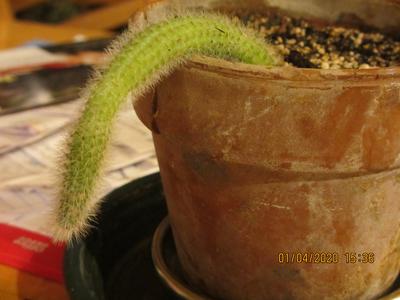
Picture of limp rat tail cactus
Hello,
Well, this is a cactus, but I think they are a type of a succulent.
I started this cactus from a very small cutting and was very very pleased with it’s growth until it took a tumble.
That put a little narrowing “bump” in it, but it came back strong.
Then while it was sitting in its normal spot on the shelf in the picture window- with it’s “nose” kind of hanging over the shelf closest to the window- we had a terrible and immediate cold snap and it seemed to get kind of frost bitten. That seemed to be the end of it.
Then the weather was really weird and the humidity levels inside totally unmanageable, I over watered it for what it was able to absorb.
By the time I figured this out, this poor little plant had become fairly limp with it’s nose still looking a different shade of green, than the rest of the plant, from the “frost bite”.
Finally I cut back the watering a lot to allow it to dry out and it just keeps getting more limp.
Now I started doing a “flooding” letting water run through and out (now with a little fertilizer as a last resort) alternating with almost complete drying. That’s why the strainer is under the pot inside the tray just to be sure it is completely draining.
But it is still getting thinner and limper. I don’t think it has enough roots to be delivering proper water to the plant.
It is in proper cactus soil that drains really well, but I am not sure- can’t recall clearly- if it always was that way or if I switched that out somewhere along the way.
I just don’t know what to do with this anymore and I’m afraid it is all but done. I am including 4 photos. Hope they show well enough.
I can’t tell if all 4 photos got loaded(?) I will try them again.
Comments for My Rat Tail Cactus is very very unhappy and maybe nearly dead
Jan 05, 2020
Just one picture…
by: Jacki Cammidge, Certified Horticulturist
Which is enough, plus your great write up. I need as much information as I can get, which you’ve given me.
I’m so sorry to say that this plant may be done. You indicate that it got cold – these plants are not that hardy, and below a certain temperature they won’t recover. However, if there is any hope at all, it’s that maybe there is a bud that escaped the cold. With time, this may emerge from under the soil level and grow. Don’t give up too quickly!
I suggest, and you may have already gathered this, because the roots are very sensitive to excess water, they may not be working very well.
I would treat this plant like a new cutting, and not water it.
They also have a dormant period, which is right now. During this time they may look almost dead, and they’ll revive in the spring with lengthening day light, and warmer temperatures.
Good luck, have patience. Put the plant on ‘ignore’ and let it recover without your worrying. If it makes it, you’ve learned something. If it doesn’t, you’ve also learned something and can do better next time.
Jan 05, 2020
Also
by: Jacki Cammidge, Certified Horticulturist
Please stop fertilizing it. This won’t do any good at all, in fact, it may be the final straw.
These plants originate high up in tree tops, so they don’t have any use for fertilizer. Plus, it will burn the roots, which are already compromised.
Jan 05, 2020
Thanks for your advice, but…
by: Jeanette
Thanks so much for your advice. I just want to be very clear about it tho. Do you mean just stop watering it altogether? And for how long…until it starts to recover or completely dies?
Also, where should I keep it? How much sun and heat?
That’s all the questions I can think of right now. Many thanks and kind regards.
Jan 06, 2020
You nailed it
by: Jacki Cammidge, Certified Horticulturist
Yes, stop watering completely until it either recovers or dies totally. Continuing to keep the soil wet if it’s got damaged roots won’t help. Give it a rest until the spring.
As for temperature, somewhere that stays above freezing, like a back bedroom or a place that isn’t used a lot is best. If possible, with a grow light and away from the window so it doesn’t get frozen again. For light, bright light, but not full sun (wherever you live, you may not be getting sun at all, these days!) Again, a grow light is crucial. Set the timer to 12 hour on, 12 hours off, so it gets the correct day length.
Best of luck with it – keep us posted!
My poor little rat tail cactus is now limp and lifeless, now what?
by Jeanette
(Madison, wi)
Hello, my tablet is in the shop. So no picture today. Suffice it to say my Rat Tail cactus is nothing to look at anyway.
It is still sitting under the grow light and I have resisted watering it. You said it might still have a “bud” that will grow. So, if it does, what do I do with the plant now to give it the best chance of coming forth?
Do I continue to leave it under the grow light? When do I finally water it? What else do I need to do or know about this?
Thanks much, jw
Comments for My poor little rat tail cactus is now limp and lifeless, now what?
Jan 15, 2020
Be Patient!
by: Jacki Cammidge, Certified Horticulturist
The recovery process could take a while. You’ll be leaving it under lights until spring arrives. To water it, spray or sprinkle a tiny amount close to the stem where it comes out of the soil, but not on the plant itself. If roots are still alive, this is where it will need it most.
The roots may be alive, and if there’s a bud under the soil that didn’t get too cold, it will emerge once spring comes. There’s no rushing this process.
Please do continue to send pictures of the progress. It helps me to give you more information (and encouragement) if I can see what’s going on.

